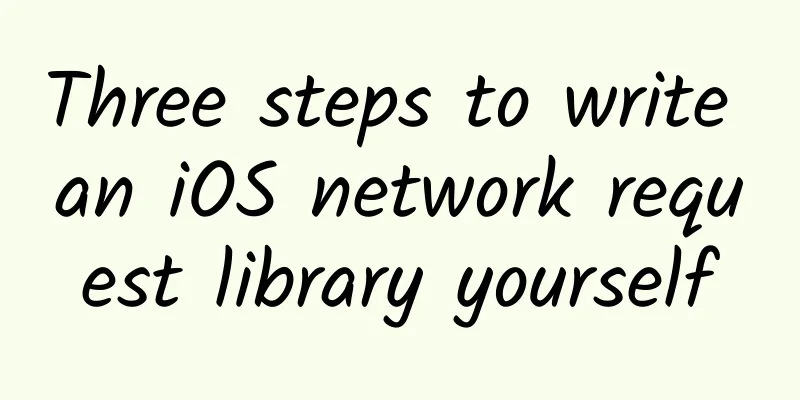Three steps to write an iOS network request library yourself

|
Code example: https://github.com/johnlui/Swift-On-iOS/blob/master/BuildYourHTTPRequestLibrary Open source project: Pitaya, an HTTP request library suitable for uploading large files: https://github.com/johnlui/Pitaya In this series of articles, we will try to build our own network request library using NSURLSession technology. Introduction to NSURLSession NSURLSession is a new network request interface introduced in iOS7, which was introduced in detail in WWDC2013. Here is a slide describing its structure: When the application is in the foreground, NSURLSession is no different from NSURLConnection, but Background Session is more flexible after the program switches to the background. Try NSURLSession Preparation Create a new single-page application called BuildYourHTTPRequestLibrary and place a button called Request in the center of the page: Drag and bind the Touch Up Inside event: Using NSURLSession Fill the mainButtonBeTapped function with the following code:
Successful use! Feeling Asynchronous asynchronous Rewrite the code of the mainButtonBeTapped function:
Try again. There is a five-second interval between the two prints. The main thread is not blocked, proving that NSURLSession is executed asynchronously. block Try clicking it multiple times and we can see it execute every five seconds until all are finished. NSURLSession uses an "asynchronous blocking" model, that is, all requests enter thread 2# for execution after being issued, and are executed in blocking queue mode within thread 2#. #p# Open source project: Pitaya, an HTTP request library suitable for uploading large files: https://github.com/johnlui/Pitaya In this chapter, we will try to use a class to encapsulate our previous code, and try to add the function of dynamically adding HTTP parameters (params), and then encapsulate a powerful interface.
Basic package Basic preparation Create a new empty Swift file, name it Network.swift, write a Network class in it, and then write a static method request():
Modify the button function in ViewController:
Run the project and click the button. The effect is the same as before. Custom HTTP method and URL Modify the request() method and pass in the HTTP method and URL:
Modify the previous function call:
Run the project and click the button. The effect is the same as before. Use closures to handle request results Functions are first-class citizens in Swift. Closures can be used as function parameters and return values, which is very powerful. Next, we use closures to process the return value of network requests. Modify the request() method and pass in a closure:
Use closures to process results in the previous function call:
Run the project and click the button. The effect is the same as before. Dynamically add Params GET method Under the GET method, params is directly attached to the end of the URL after being url-encoded and sent to the server. Modify the request() method and pass in a params dictionary:
To process params, we steal the params processing function from Alamofire. If it is a GET method, then add the processed params to the end of the URL. The complete code of the Network class is as follows:
Modify the previous function call:
http://pitayaswift.sinaapp.com/pitaya.php is the server code I deployed for testing, which will directly return ooxx in ?get=ooxx. Run the project and click the button to see the effect: POST method There are several protocols to choose from under the POST method. There is no file upload here, so we use the simpler application/x-www-form-urlencoded method to send the request. Add some code to the request() method:
Modify the previous function call:
Use POST to send a request, and the server will also return the value of the key post. Run the project and click the button. The result is the same as the previous GET method. At this point, the interface encapsulation is completed! #p# Open source project: Pitaya, an HTTP request library suitable for uploading large files: https://github.com/johnlui/Pitaya In this article, we will work together to reduce the coupling of the previous code and use the adapter pattern to implement a network API independent of the underlying structure to create a real network request "library". Reduce coupling How to reduce coupling The current clear soup noodle style code is easy to understand, but the function is single and the code is messy. Let's analyze the use process of NSURLSession: Constructing NSURLRequest Determine the URL Determine the HTTP method (GET, POST, etc.) Adding specific HTTP headers Filling HTTP Body Drive the session.dataTaskWithRequest method to start the request Specific implementation Create another NetworkManager class under Network, set URL, params, files, etc. as member variables, and initialize them in the constructor:
Afterwards, the above analysis 1. Determine the URL 2. Determine the HTTP method (GET, POST, etc.) 3. Add specific HTTP headers 4. Fill in the HTTP Body Encapsulate the first three steps into one function, encapsulate the last step into one function, and then encapsulate the code that drives session.dataTaskWithRequest into one function:
Then use a unified method to drive the above three functions to complete the request:
At the same time, don't forget the three parse params functions stolen from Alamofire, and put them in this class. So far, the work of reducing coupling is basically completed, and then we start to encapsulate the "network API". Encapsulating "network API" using the adapter pattern Understanding the Adapter Pattern The adapter pattern is a design pattern that is easy to understand: my app needs a function to get the string returned by a URL. I currently choose Alamofire, but the developing Pitaya looks good. I want to replace it with Pitaya in the future, so I encapsulate a layer of my own network interface to shield the underlying details. When the time comes, I only need to modify this class, and there is no need to go deeper into the project to change so many interface calls. The adapter pattern sounds high-sounding, but it is actually a design pattern that we use very commonly in daily coding. Do it! Modify the code of the Network class to:
Done! Encapsulating multi-level interfaces Interface without params:
Two get interfaces (with and without params):
Two post interfaces (with and without params):
Test interface Modify the calling code in ViewController to test the multi-level API:
Run the project and click the button to see the effect: Multi-level API encapsulation is successful! [Editor: chenqingxiang TEL: (010) 68476606] |
<<: Nintendo's next-generation console will use Android system
>>: Write an iOS network request library by yourself - encapsulation interface
Recommend
Will WP become the real 1% in 4 years?
The mobile operating system market has always bee...
How to build a personal brand?
This article will give you a clear answer once an...
Toutiao account optimization plan!
"Whatever does not destroy me will make me s...
In terms of supporting the common growth of the supply chain, we expect Chinese automakers to give excellent answers.
While you are hurrying along with your head down,...
Insights into e-commerce information flow advertising in 2019!
The transaction volume of the Double Eleven battl...
Is it expensive to customize the Yichun meat and poultry mini program? Yichun meat and poultry mini program customization cost and process
What is the price for customizing Yichun meat and...
OPPO, vivo, Xiaomi, Huawei: Among the four domestic companies, who is the marketing veteran?
OPPO and vivo , which were ridiculed as factory g...
The meat I bought jumped, what's going on? How to choose meat, you will understand after reading this
As the New Year approaches, many families begin t...
The latest Douyin live streaming sales operation manual in 2020!
Live streaming sales has never been an easy task....
6 Keyword Bidding Rules, Will You Still Worry About Lack of Traffic After Learning Them?
To put it simply, bidding means spending money to...
Exposed! Can you eat the grilled sausages that cost 2 yuan each on the street?
Expert of this article: Pa Lize, Chief Physician ...
IEA: Global Energy Investment Report 2024
The IEA has released the "Global Energy Inve...
Doctors warn: This change in nails may be cancer! Don't take it lightly
When you cut your nails, have you ever noticed th...
Because of wild boars and border collies, we have made new friends in the past year.
Biologists are constantly discovering, identifyin...
The Double 11 battle is coming, don't worry, I'm not asking you to spend money
[51CTO.com original article] It is November at th...









